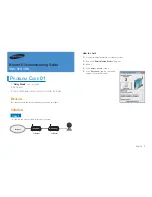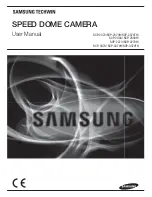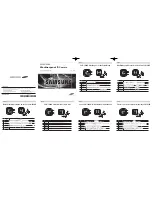
F
Operating considerations Notes to users
1. Important safety notes
・
Use this camera with a 12VDC power supply. Time will be needed for about four seconds by the time the camera works
normally after turning on the power supply.
・
Observe that flammable objects, water or metal do not enter the camera interior. These may lead to failure or accident.
・
Do not modify the camera or use the camera with external covers removed. These may cause failure, void any warranties and
pose a safety hazard.
・
Stop using the camera at the approach of electrical storm (thunder audible). Protect the camera from rain if using it outdoors.
・
In event the camera shows any abnormality, switch off the camera and disconnect the power cord. Contract a Hitachi Denshi
service representative.
2. Handling
・
Do not attempt to remove cover.
・
When installing or removing a lens, be sure to use care that water or dust dose not enter the inside of the camera.
3. Installing and storage
Avoid installing or storing the camera in the following environments.
・
Environments exposed to direct sunlight, rain or snow.
・
Environments where combustible or corrosive gas exists.
・
Excessively warm or cold environment (Operating ambient temperature: -10 to 50
℃
).
・
Humid or dusty environment.
・
Place subjected to excessive vibration or shock.
・
Environment exposed to strong electric or magnetic field.
・
Do not aim the camera lens at the sun.
・
Do not shoot strong light.
When such a scene is shot, vertical trailing will appear. However, this is not due to failure. In case strong light enters camera
through the lens, partial
deterioration in picture quality will result.
4. To obtain stable performance for long time
When the camera is used continuously for long time
under high ambient temperature, the inside electrical parts become
deteriorated, resulting in shortening its life.
To use the camera continuously for long time, the highest temperature must be below
40
℃
.
5. Connectors
Confirm the power is off before connecting or disconnecting a signal cable. Grasp connectors by the body, not the attached wires.
6. Cleaning
・
Use a blower or a lens brush to remove dusts on the lens or the optical filter.
・
Wipe dirts on the case off with dry soft cloth. If dirts are hardened, wipe them off with cloth moistened with neutral detergent
liquid; wipe the cover with dry cloth.
・
Do not use benzene, thinner, alcohol, liquid cleaner or spray-type cleaner.
・
In event dust or other debris is lodged between the CMOS and optical filter, consult dealer for cleaning by an optical technician.
7. Phenomena inherent to CMOS imaging device
The following phenomena are inherent to a charge coupled device imaging element and do not indicate malfunction.
1) Fixed pattern noise
High ambient temperature can cause fixed pattern noise to appear throughout the scene.
2) Moire
Interaction between patterns can produce an additional "phantom" pattern to appear. The CMOS picture elements (pixels) are
arranged in a pattern, which can interact with a pattern in the scene (e.g., a performer wearing a finely striped necktie) to result
in a Moire pattern. The effect should be considered when selecting costumes, props and other scene elements.
3) Ghosting
Strong direct or reflected light near an object of interest can cause ghosting of the object to appear in the picture. The effect is
more obtrusive with certain iris settings and lens types. Select the scene layout and camera pointing direction carefully in
order to avoid this effect.
4
)
Defective pixels
Imperceptible white spots may rarely come up on the screen due to cosmic rays and so on. It becomes easy to appear when
the sensitivity of the camera is raised in the operation at the high temperature.
5
)
Monochrome reversing
When taking picture of personally strong light, the part where white is saturated might become CMOS element with a black
image. Please adjust quantities of light at such time.
6
)
Horizontal pull phenomenon of image
Subject might became bright when there is strong light (strong reflection of the light, the fluorescent lamp, and sunlight etc.)
next to subject. It becomes easy to see by raising the camera sensitivity. It appears only when using it by the Full configuration.
7
)
Horizontal line noise when electronic shutter is used
The horizontal line noise might appear by setting the exposure time when using it in a normal mode. It becomes easy to see by
raising the camera sensitivity.
8. Attention about laser light
Laser light may do damage to CMOS image sensor. When you use laser light, be careful not to irradiate it on the CMOS image
sensor surface. The CMOS image sensor breakage by laser light irradiation is out of warranty. (The repair is not free of charge.)
Summary of Contents for KP-FM200WCL
Page 6: ...E ...






































